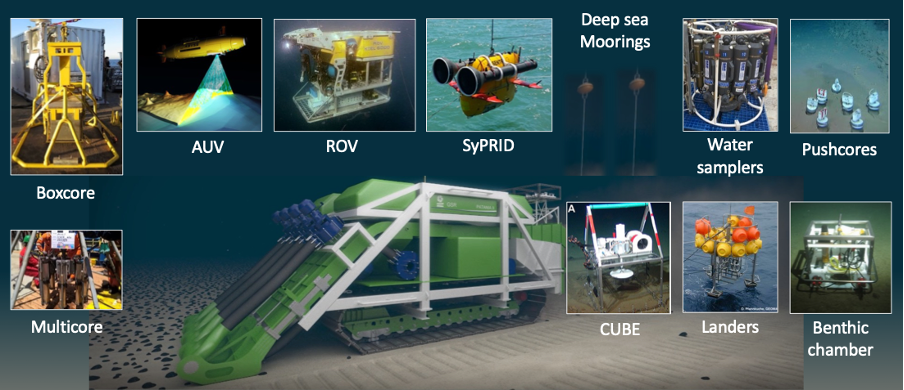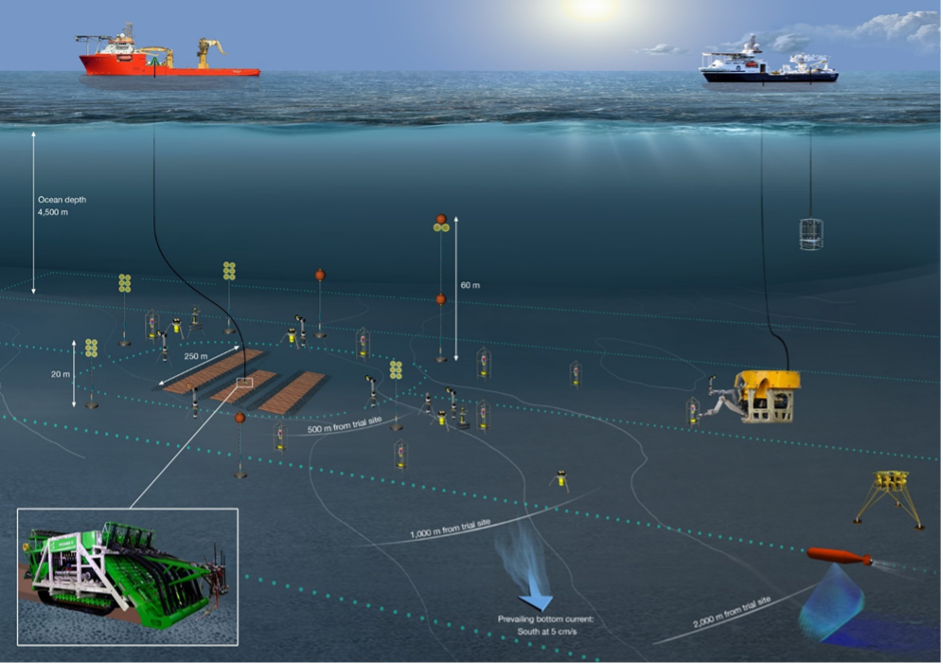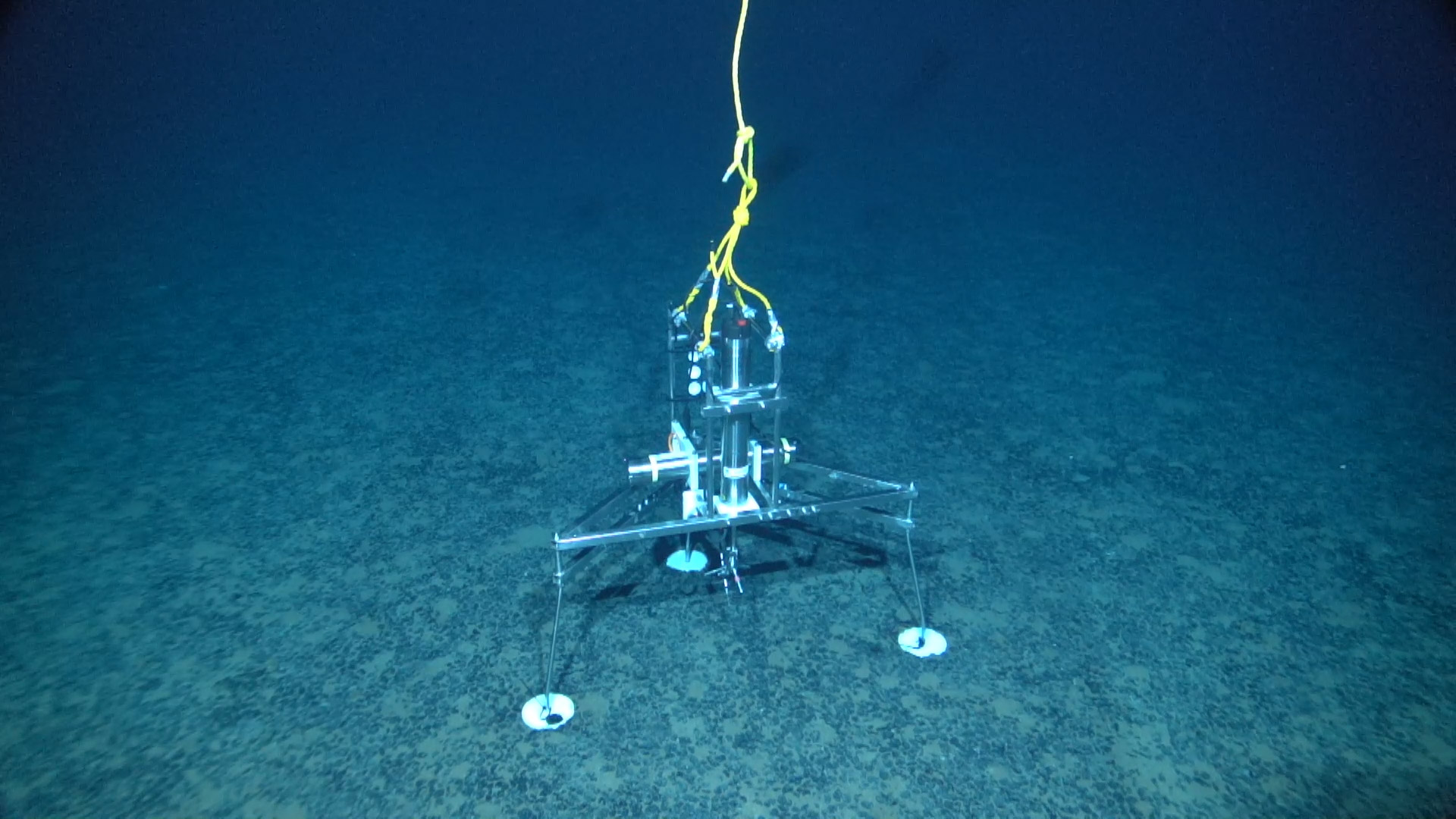Until recently, researchers needed to rely on calculations, computer modelling and laboratory simulations to estimate the impacts of deep-seabed mining.
Now, monitored ultra-deepwater technology trials have provided real-world insights into the expected impacts and effects of commercial-scale polymetallic nodule collection.
In 2021 and 2022, two polymetallic nodule exploration companies trialled their nodule collector technology in three different ISA contract areas within the Clarion Clipperton Zone (CCZ) of the Pacific Ocean.
During the 2021 trials, Global Sea Mineral Resources (GSR) carried out testing of its pre-prototype seafloor nodule collector (Patania II) in the GSR (Belgium-sponsored) and the Federal Institute for Geosciences and Natural Resources (BGR, German-sponsored) exploration contract areas. Environmental monitoring was conducted from the GSR-chartered vessel by scientists including those from the Massachusetts Institute of Technology (MIT) and additional independent monitoring was carried out by the MiningImpact consortium of scientists using a separate research vessel.
MiningImpact comprises scientists from 29 European institutes and nine countries, as well as BGR.
The purpose of the Patania II trial was threefold: 1. Test the technology under different set-up conditions and driving patterns, 2. Increase knowledge about environmental impacts and effects of seafloor nodule collection, and 3. Test and improve deep-sea monitoring capabilities.
The scientists from MiningImpact and MIT conducted a comprehensive range of environmental monitoring studies including but not limited to:
- Sediment plume dispersion: near-field to far-field
- Near-field plume (“selfie” manoeuvre): Scientists attached sensors to the collector and had it turn and drive back through its own plume to sample sediment concentration immediately after disturbance, capturing plume behaviour within minutes of it being created. Understanding this initial behaviour is critical for accurate predictions.
- Far-field plume (“drive-by” manoeuvre): Sensor-laden moorings were deployed some distance from the tracks to capture the sediment plume as it drifted and dispersed over hours, monitoring evolution and dilution of sediment cloud over time and space.
- Biogeochemical and ecological monitoring
- In-situ oxygen profilers, incubation chambers, and sediment pumps were used to measure oxygen levels, microbial turnover, and biogeochemical fluxes in plume-impacted zones.
- Box-corer sediment sampling and laboratory analyses, conducted during research expeditions in 2019 (pre-impact), 2021 (pre-, and post-impact) and 2022 (post impact), were used to assess impacts on organic matter, phytopigment concentrations, biopolymeric carbon, microeukaryote diversity, and trophic status.
- Ecotoxicology and trace-metal release
- Scientists analyzed the potential release of trace metals from suspended sediment, deposition layers, and effects on fauna living in and on the seabed.
- Acoustic noise measurements
- Noise data was recorded using ocean-bottom hydrophones deployed around the trial sites to assess underwater sound emissions generated by the Patania II operations.
Instrument deployment and sensor network
Over 50 inter‑calibrated hydro‑acoustic and optical sensors measured suspended sediment concentrations and particle size, deployed on the seabed around the test site.

Some of the marine scientific research equipment used to monitor the Patania II trial.
Source: GSR and MiningImpact

A graphic representation of the monitoring equipment deployed for GSR’s Patania II trial in the Pacific Ocean in 2021. Source: GSR Patania II Expedition Report
Autonomous Underwater Vehicles (AUVs) and Remotely Operated Vehicles (ROVs) provided 3D mapping of plume dispersion, seafloor topography, and visual imagery of plume and cleared tracks.

Example of post impact monitoring: photo-mosaic of the seafloor after the Patania II trial, constructed from ~50,000 images taken using an AUV at high resolution (less than 10 millimeters). What appear as black dots in the image are piles of nodules which were deposited on the seafloor by Patania II.
Source: GSR, MiningImpact
Oceanographic moorings with Acoustic Doppler Current Profilers (ADCPs) and turbidity meters assessed sediment plume properties (e.g. current speed, concentration, grain size, altitude) in the medium‑field.
Summary of study types
| Study type | Instruments/Methods |
|---|---|
| Sediment plume monitoring | Selfie & drive by manoeuvers, sensor arrays, AUV/ROV, moorings |
| Seabed mapping | AUV / ROV imagery |
| Biogeochemistry & ecology | Oxygen sensors, incubation chambers, box corers, multiple corers |
| Trace metal & ecotoxicology | Water & sediment sampling, microbial assays |
| Underwater noise emissions | Ocean bottom hydrophones measuring in situ soundscape |
In 2022, Nauru Ocean Resources Inc. (NORI), in partnership with Allseas, conducted a full-system trial of a polymetallic nodule collector, riser and vessel in the NORI exploration contract area of the CCZ. This trial was similarly monitored by researchers.
Together, these efforts are providing a detailed, multi‑dimensional picture of how commercial-scale polymetallic nodule collection can be monitored. The data are foundational for developing monitoring standards, designing mitigation strategies, and informing regulatory frameworks.
Scientific Learnings
The Patania II expedition provided groundbreaking insights, particularly concerning sediment plumes. Key findings include:
- Sediment disturbance: 3 to 5 cm of the top sediment layer is disturbed, much less than the 10 to 20 cm previously predicted.
- Sediment plume behaviour:
- the sediment plume starts as a turbidity current with sediment-laden water spreading under its own weight away from collector tracks.
- Most of the sediment (92–98%) stuck close to the seafloor, meaning that the plume spread mostly along the ocean floor, not up into the water column.
- There was heavy local deposition, meaning that much of the sediment re-settled close to where it was lifted.
- Noise: Studies performed by the MiningImpact2 consortium of scientists show that, within 400 meters from the source, noise created by a polymetallic nodule collection trial on the seafloor decreased to around 80 dB (well below known acoustic damage and disturbance threshold criteria for cetaceans)
Outlook and continuing research
The GSR and NORI trial sites were revisited 18 and 12 months, respectively, post-trial to assess the longer-term effects and further return visits are planned. A key focus now is to scale up these learnings to inform predictions for commercial operations.
These trials demonstrate that it is possible to monitor the impacts and effects of deep-seabed mining through the deployment of advanced technology and international scientific collaboration. It is expected that future monitoring will see advances in efficiency and automation[1].
Useful links:
The GSR Patania II Expedition: Technical Achievements and Scientific Learnings
New High-Tech Flexible Networks for the Monitoring of Deep-Sea Ecosystems
GEOMAR: DeepSea Monitoring | a multidisciplinary research group that listens, watches and computes
[1] For example, initiatives such as the TRIDENT project, which is funded by the EU Horizon Europe programme, aim to develop autonomous technologies equipped with advanced sensors for near real-time monitoring for applicable parameters. Not every parameter will be able to be measured in real-time (e.g. in cases where water or sediment sampling and subsequent analysis is required).

